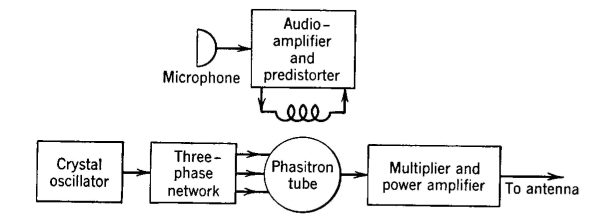| Electrical Communication is a free textbook on the basics of communication technology. See the editorial for more information.... |

|

Home  Radio Systems Radio Systems  Frequency-Modulation Radio- Telephone Transmitters Frequency-Modulation Radio- Telephone Transmitters |
|||






|
|||
Frequency-Modulation Radio-Telephone TransmittersTransmitters for frequency-modulation are not standardized like those for amplitude modulation. They differ fundamentally in two important ways; first, the method of modulation; and second, the method of stabilizing the center frequency. Several methods of frequency modulation have already been discussed. The methods of frequency stabilization are too varied and detailed for consideration. The center frequency must not drift more than 2000 cycles from the assigned value.51 A summary of the methods is given in the reference accompanying Fig. 28. A block diagram of a frequency-modulation transmitter is shown in Fig. 28. The modulation is accomplished in most transmitters at a carrier frequency of several hundred thousand cycles and with a fairly low maximum frequency deviation. Also, modulation is accomplished at a low power level using receiving-type tubes; this is a decided advantage of frequency modulation. The frequency multipliers increase both the frequency and the frequency deviation to the correct values, and the power amplifier increases the power level to the proper amount. Because the frequency-modulated wave has constant amplitude, the class C power amplifier operates at constant load. At the very high frequency of approximately 100 megacycles, special tubes and circuits are used. Input and output tuned circuits of the "coaxial-cable type" instead of inductors and capacitors are common. Although this section has been devoted to frequency-modulation telephone transmitters, it should be mentioned that frequency-modulation radio telegraph transmitters also are used extensively. These employ what is called2 frequency-shift keying or FSK (see also page 335).
|
|||
Home  Radio Systems Radio Systems  Frequency-Modulation Radio- Telephone Transmitters Frequency-Modulation Radio- Telephone Transmitters |
|||
Last Update: 2011-05-30


